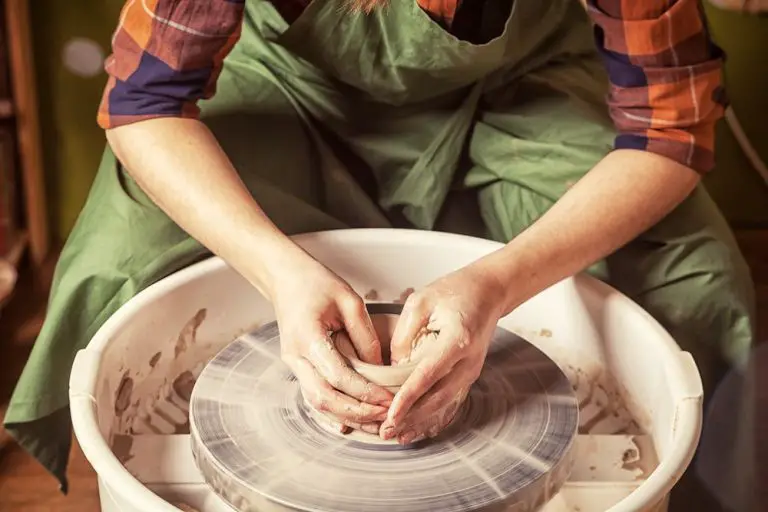What Is Greenware Vs Bisque?
Greenware and bisque are two types of pottery that are commonly used in ceramics. Greenware refers to unfired clay that has been shaped into an object. Bisque is greenware that has gone through a first firing process, making it more durable. The main goal of this article is to understand the key differences between greenware and bisque pottery.
Definition of Greenware
Greenware refers to unfired clay pottery and ceramics. After clay is shaped into the desired form, it is allowed to air dry until it becomes soft and fairly solid. At this stage, the clay contains moisture and is fragile. Greenware has not been fired in a kiln yet, so it still contains water within the clay body. If the greenware piece is tapped it will have a dull sound, and the clay can still be easily dented or scratched with a fingernail. The texture is smooth but not fully hardened.
Examples of greenware include handbuilt or wheel thrown pottery, ceramic figurines, tiles, and decorative clay objects that have air dried but have not yet undergone the firing process. The clay maintains its porous, muddy properties. Because it is unfired and fragile, greenware must be handled very gently to avoid cracking or damaging the soft clay body. Any additions like handles and decorations must be attached while the clay is in the pliable greenware stage before firing.
Making Greenware

Greenware is made by sculpting unfired clay into the desired shape. There are several stages in the greenware making process:
- First, the clay is wedged or kneaded to remove air bubbles and make it uniform in consistency.
- Next, the clay is shaped by handbuilding techniques like pinch pots, coils, slabs, etc., or thrown on a potter’s wheel.
- Once the basic form is created, details can be added by carving, adding appliques, or attaching separate parts.
- The clay is allowed to dry slowly to reach the leather hard stage where it is still pliable but able to hold its shape.
- Finally, it dries completely to the bone dry stage where it is ready for the first firing.
This process allows the clay to be worked into the desired shape before it is hardened through firing. The clay remains porous and fragile in the greenware state until fired into bisqueware.
Definition of Bisque
Bisque refers to clay pieces that have been fired once at a relatively low temperature, typically around cone 04-06 which is approximately 1,815–2,040°F (990–1,110°C). This initial bisque firing hardens the clay body and makes the piece more durable and easier to handle. Bisqueware is porous and absorbent since it has only been fired at a low temperature. The bisque firing prepares the piece for the final glazing and high temperature firing. During the bisque firing, any water and chemicals in the clay are evaporated, the clay particles partially fuse together, and the piece achieves bisque hardness.
According to the article on Wheel & Clay, bisque firing transforms soft, fragile, greenware clay into a hard, durable bisque piece that is ready for glazing and final firing to reach its glasslike, non-porous finished vitreous state. The bisque firing shrinks the piece slightly, hardens it, and prepares it for the application of glazes.
Bisque Firing Process
The bisque firing process is a key step in transforming soft, unfired greenware into hardened bisqueware ready for glazing and final firing. During bisque firing, the clay body undergoes important physical and chemical changes.
In the kiln, the temperature is slowly raised to around 1000-1100°F. As the clay heats up, the water evaporates out of the body through steam. The clay particles vitrify, which fuses them partially together. Organic matter burns out. The bisque firing results in a porous, dry, hardened material.
One of the most noticeable effects is color change. As clay bodies fire, they usually lighten and take on a more neutral bisque color, ranging from white to buff to light brown or salmon pink. The original clay color becomes more muted. In addition to color change, the bisqueware has a rougher surface texture than the unfired greenware.
Firing to bisque temperature strengthens the clay body through partial vitrification. This makes the ware less fragile and absorbent compared to greenware. Bisqueware is now ready to apply glaze and complete the final firing process into a finished ceramic piece.
Comparing Greenware and Bisque
Greenware and bisque represent two different stages in the pottery making process. The main difference between them is that greenware is unfired clay, whereas bisque has gone through an initial firing process. This leads to some key contrasts in their properties:
Greenware is soft, wet, and extremely fragile. The clay maintains the moisture content from when it was first shaped. As it is unfired, the clay particles are not fused together through vitrification. This means greenware cannot hold its shape well – it sags, slumps, and is prone to cracking. The soft surface is easily dented or damaged. Greenware must be handled very gently and supported from underneath.
In contrast, bisque ware has been fired in a kiln, causing the clay to harden permanently into a ceramic material. The firing process removes all moisture from the clay and fuses the particles, creating a hard, durable bisque. Bisque is no longer fragile or easily dented. It maintains its shape without sagging. While less delicate than greenware, bisque can still chip or crack if handled carelessly. The porous surface readily absorbs water, requiring a glaze to make it watertight.
So in summary, greenware is extremely soft, fragile, and untempered clay, while bisque is the hardened, fired ceramic state. The fragility versus durability of the two makes a major difference during the pottery creation process.
Uses of Greenware
Greenware is primarily used for creating unfired clay shapes and sculptures. Before clay is fired in a kiln, it is in a malleable, soft state known as greenware. Ceramic artists will shape and sculpt the greenware into the desired form before doing any firing. Common greenware items include bowls, mugs, plates, figurines, vases, and decorative sculptures. The greenware stage allows the artist to freely shape and mold the clay how they wish. Details can be easily added at this stage before the structure of the clay is permanently set through firing.
Once the greenware pieces are complete, the artist will allow them to air dry until they are hard enough to handle without deforming. They are then ready to be fired in a kiln to convert them into finished ceramic ware. Greenware is an essential stage in ceramic art, providing the base unfired clay medium for artists and crafters to sculpt and shape their creative works. The possibilities are endless when working with malleable greenware clay before committing the structure to its final fired bisque form.
Uses of Bisque
Bisque is primarily used as the stage before the final firing and glazing of ceramic pieces. At the bisque stage, the clay has been fired once to harden it into ceramic material, but it is still porous and able to absorb water. This porosity allows glazes and slips to be applied and absorbed evenly into the clay body. Decorations can also be applied at this stage, as the bisque ware provides a hard, stable surface for painting, staining, etching, etc. Once the desired glazing and decorating is complete, the bisque piece is fired a second and final time to melt the glazes, seal the surface, and complete the ceramic object. The bisque firing is a crucial intermediary stage that prepares the piece for glazing and the final firing. It transforms the greenware into a true ceramic material capable of accepting glazes and decorations.Source
Glazing and Final Firing
After bisque firing, the next step is to apply glaze to the bisque ware before the final high temperature firing. Glazes are made from finely ground glass that melts and fuses to the bisque during high temperature firing, creating a glossy, non-porous surface. There are many types of glazes to choose from, including transparent, opaque, and metallic glazes in a variety of colors. Glazes can be applied by dipping, pouring, brushing, or spraying. This video shows the process of glazing bisque ware using a pouring technique.
Once the bisque ware is glazed, it undergoes a final high temperature firing in the kiln. This is often around 2200°F (1200°C), higher than the bisque firing temperature. The glaze melts during this firing and fuses to the clay body, creating a durable, finished piece. The final firing process vitrifies both the glaze and the clay body underneath, making the ware non-porous and water-resistant. This complete firing process transforms soft, porous greenware into a hard, finished ceramic object.
Conclusion
In summary, greenware and bisque are two important stages in the pottery creation process, but have distinct differences. Greenware refers to unfired clay that has been shaped into its final form. It is soft, fragile, porous and water-soluble. Bisqueware refers to pottery that has been fired once at a low temperature to harden it and prepare it to be glazed and fired again. Bisque is hard, durable, and non-porous but still absorbent.
The main uses of greenware are for drying, smoothing and refining the pottery piece before doing the initial bisque firing. The bisque stage allows applying glazes and decorations that get fused permanently in the final high temperature firing. Understanding the unique properties and purposes of greenware vs bisque enables potters to create beautiful finished ceramic art.



